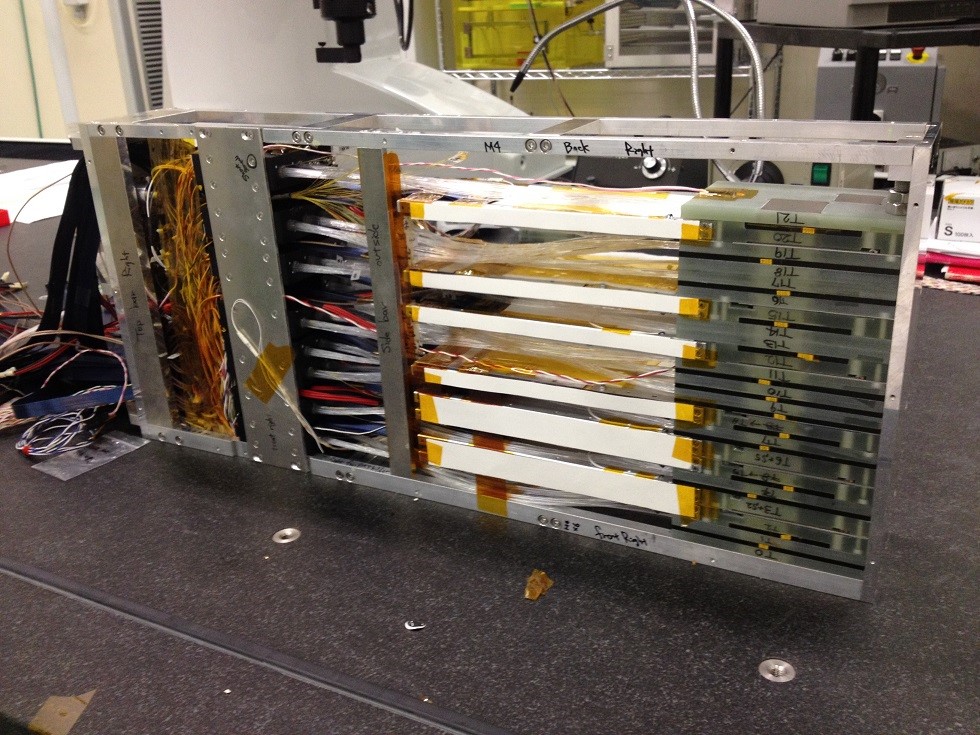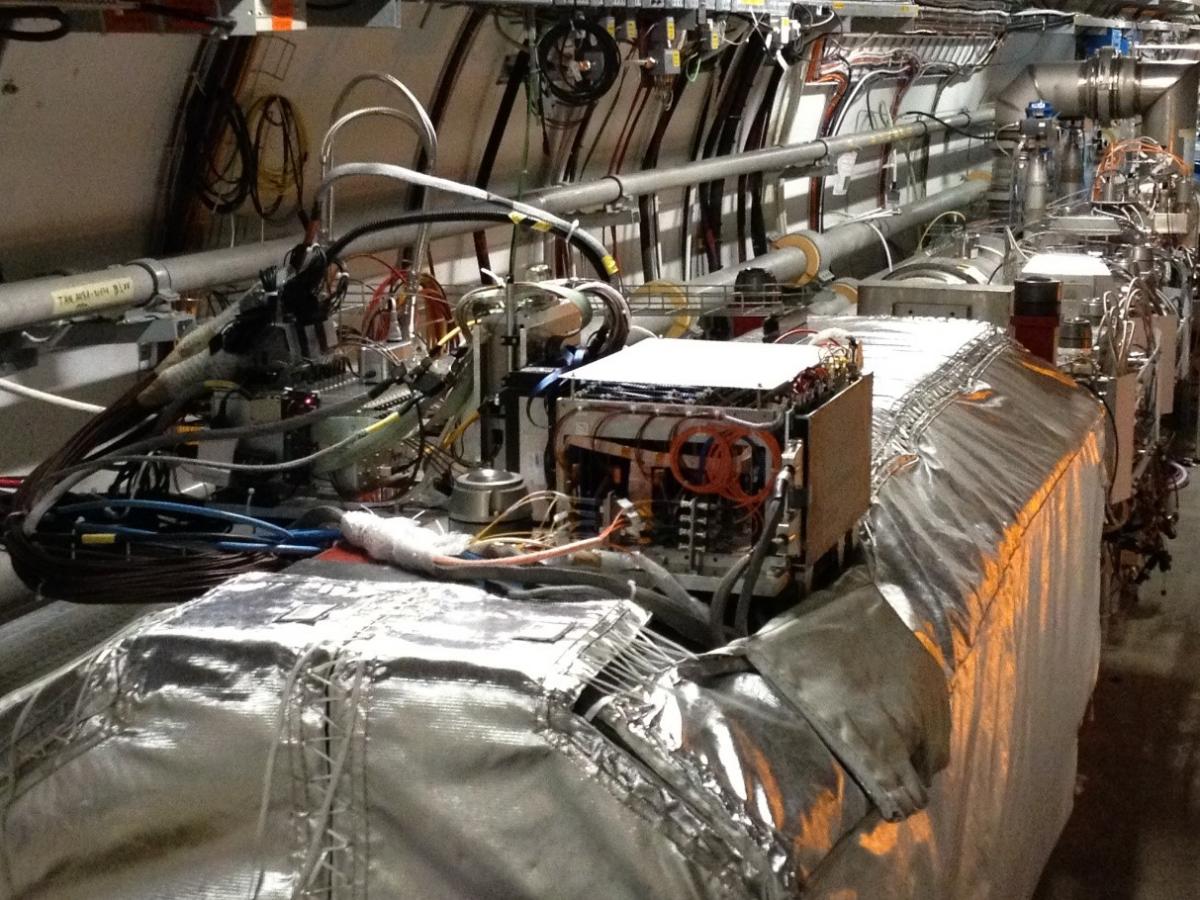LHCf sheds light on hadronic interaction models
The experience of the small LHCf collaboration, matured within the cosmic ray physics community, began in 2004 with the idea of designing a very thin detector to be installed along the LHC beam line, in such a way to cover the so called “very forward region” of the collisions. The basic purpose of such an experiment was to catch the very high energy debris emitted during collisions at small angles with respect to the interaction line, which are impossible to be measured using the large detectors surrounding the LHC interaction points. The measurement of the energy and angular spectra of these particles is an important ingredient required to enable calibrating hadronic interaction models, which are widely used for the description of the development of the so called Extensive Air Showers (EAS), particle cascades produced by extremely energetic cosmic-ray (CR) particles interacting with the atmospheric gas.
Since the first beams were circulated in the LHC ring in 2009, the LHCf apparatus, composed of two independent sampling electromagnetic calorimeters with transverse shaping capability, has been installed several times with different collision schemes, both with protons and heavy ions and at different collision energy. The two detectors were designed to measure neutral particles, mainly single photons, neutrons or neutral pions, produced at very high pseudo-rapidity η > 8.4 in p+p collisions at an energy of 14 TeV, in the centre of mass frame and in p+A collisions. Due to the characteristics of the collisions of cosmic rays happening in the Earth atmosphere, the study of the only p+p system at a single collision energy is not enough to describe completely the real processes going on at the beginning of an EAS development. In fact, the first interactions involve mainly more complex atomic nuclei, like oxygen and nitrogen. The dynamic of p+A collisions can differ in many important aspects with respect to the more simple case of p+p interactions.
A significant reduction in the cross section in proton and heavy-ion collisions with respect to the simple superposition of p+p collisions, due to nuclear screening effects, has been found in previous measurements performed at smaller values of pseudo-rapidity and lower energy than available at the LHC; this reduction has been confirmed by LHCf itself by comparing p+p with p+Pb interactions at the LHC energy.
The measurements carried out so far by the LHCf experiment concern p+p collisions at √s = 0.9, 2.76, 7 and 13 TeV and p+Pb collisions at √sNN =5 TeV and 8 TeV. One of the LHCf detectors was then delivered and installed also at the RHIC accelerator for a further measurement to an even lower energy, performed during p+p collisions at √s = 0.5 TeV. From the point of view of cosmic rays, the energy carried by such colliding systems is equivalent to the energy of a system consisting of a proton with energy ranging from approximately 1014 eV to almost 1017 eV, interacting with a nucleus at rest. In this way, the measurement carried out at the LHC allow covering a wide range of the cosmic ray energy spectrum, which is significant for the description of the highest energy cosmic-rays interactions with the atmosphere.
The many measurement campaigns carried out by the LHCf collaboration allowed presenting to the cosmic ray community and to the developers of hadronic interaction models many results of great interest, which represent a unique opportunity worldwide. LHCf is in fact the only existing experiment measuring particles with high energy and spatial resolutions at such high values of pseudo-rapidity and collision energy. These results allowed already a comparison of predictions by different hadronic interaction models in regions of the phase space where large discrepancies among the models still exist. Figure.1 shows as an example a comparison with model predictions of the photon and neutron energy spectra measured in different angular regions around the collision line for p+p collisions at √s =13 TeV.
Figure 1. LHCf-measured energy spectra of forward photons (left) and neutrons (right) in p+p collisions at √s =13 TeV.
Model developers are currently working to include the information obtained by the LHCf forward measurements in their models.
Two main points of interest for the cosmic ray community, which could be addressed at the LHC collider, are currently missing or not completely realized: a joint study of the forward and the central pseudo-rapidity regions and the measurement of particles emitted in the central and forward regions in proton collisions with light ions. The former one, currently under development as a joint effort of the ATLAS and LHCf collaborations, was made possible thanks to the implementation of a common data taking framework implemented since 2013, which allowed collecting independent ATLAS and LHCf data sets for which the corresponding triggers can be easily identified. The latter point is now being studied by the LHC experts, after the LHCC and CERN Research Board approved the Technical Proposal presented by the LHCf collaboration for the LHC Run 3 and to support the idea of realizing collisions involving light ions.
The LHC Run 3 represents for LHCf a new opportunity to shed light on the physics of the hadronic interaction of CRs with the atmosphere, and to contribute to an improvement of the hadronic interaction models. The main reasons that led our group to submit a Technical Proposal to take part in Run 3 concern both p+p and p+O collisions.
The opportunity to take data for pp collisions at 14 TeV would allow LHCf to extend the range of energies explored during the previous operations. The LHCf group expects to improve in a significant way the physics outcome of the experimental results, thanks to the on-going hardware upgrade, to a new trigger strategy and to the joint data taking carried out with the ATLAS forward detectors. The hardware upgrade and a new trigger scheme allow us to operate at 10 times higher luminosity than in the 2015, 13 TeV proton run. Consequently we can significantly improve the collected statistics, thus opening the possibility to measure spectra of more rare neutral mesons like η and Κ0. A new combined data taking with the ATLAS central and forward detectors would open the possibility to enhance the scope of the LHCf measurements by allowing the identification of diffractive and not-diffractive collisions.
Beyond this sure improvement, the opportunity to take data in collision between protons and light ions represents a real breakthrough for the HECR physics case. There is currently a serious interest in this type of collisions, not only for the HECR field, but also in other communities. The most probable light ion collisions foreseen at LHC will use Oxygen, which is among the best possible targets for the HECR physics case. The possibility to reproduce in laboratory the first interaction responsible for the development of a real atmospheric shower, thus directly probing the high energy collisions happening in the atmosphere, will allow a significant reduction of the systematic effects that are present in the extrapolation of the LHC directly measured quantities to the widely used high energy hadronic interaction models.

Figure 2. The image shows the LHCf Arm2 detector still open, just after the assembling of the calorimeter layers.
The photo below (Figure 3) shows the LHCf Arm2 apparatus after the installation inside the TAN structure. The readout electronics is visible on top of the TAN, while the detector lies vertically, hidden inside an instrumentation slot accessing the beam line location.

Figure 3: the Arm2 detector after the installation inside the dedicated instrumentation slot of the TAN absorber in sector LSSR1, 140 m far from the ATLAS interaction point.
References
Phys.Lett. B780 (2018) 233-239
